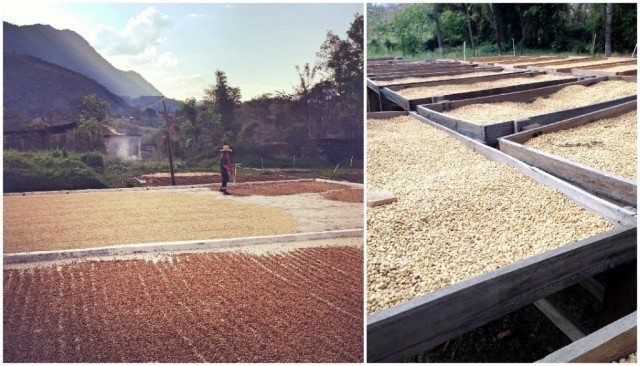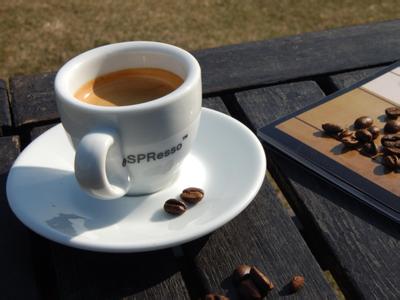The process of coffee extraction what is the Mena reaction?
A few days before his death on St. Helena Island in 1821, his attendant, Marshal Bertrand, wrote about begging for it: "he asked for twenty times in the morning and asked me if I could give him some more coffee." "No, my lord, the doctor ordered you to drink only one spoonful of coffee. It's not time yet. You have a bad stomach. Drinking early will only make you vomit early. "he has vomited nine times this morning. In the past, he used to dominate the wind and lead the army, but now he is reduced to begging for coffee and obedient like a child. Begging again and again, being rejected again and again, but not angry. The situation and the scene are sour. "

In addition to caffeine, the charming aroma of coffee is also the main reason why Naomi, me and many coffee fans miss coffee all the time. But why on earth does the coffee smell so good? The most important thing, of course, is that coffee beans themselves store a variety of raw materials, such as carbohydrates, proteins, lipids, organic acids and so on. After heating and baking, it will start a series of complex reactions, creating an attractive aroma.
Two of the most important reactions are caramelization (caramelization, oxidation and browning of sugars) and Mena (Maillard reaction, reaction of amino acids with carbohydrates). Both reactions require the participation of carbohydrates, and the rich sucrose in raw beans provides the materials needed for these two reactions. Previous studies also found that there was a positive correlation between sucrose content and coffee bean flavor. From the table below, it can be seen that the content of sucrose (Sucrose) in Arabica is twice as much as that in Robusta, which also explains why the flavor of Arabica coffee beans is better than that of Robsta.

(1) caramelization reaction
Once I ordered a cup of Guatemala-Huehuetenango near the Kaohsiung Cultural Center and spent a beautiful afternoon with "my Adventure" (My Life As An Explorer by Sven Hedin). After drinking coffee, I accidentally found that the dry coffee stains at the bottom of the cup were arranged into interesting patterns. I picked it up to see if I could see the jackpot number of the next big lottery. I didn't see 15 for a while. I think the patterns are more like an explorer marching among the rolling brown sand dunes in the desert. All of a sudden, the sweet smell of caramel flashed for a moment, and then smell it carefully, the sweet smell of caramel came from the bottom of the cup. Isn't the tiny Nanguo I ordered black coffee? Why is it sweet with caramel? Later, I found that the black coffee itself is really sweet, especially the sweetness of caramel! But the sweetness of each kind of coffee varies depending on the variety of beans and the way it is roasted.
The sugar in the coffee bean is caramelized at about 170-200 ℃, which is exactly the melting point of sucrose (185 ℃) and the temperature of the explosion stage when the coffee bean is roasted. The product of caramelization is divided into two parts:
The dehydration product of sugar is caramel or sauce.
The pyrolysis products are mainly volatile aldehydes and ketones.
Generally speaking, fire-roasted aroma, caramel and color are produced in the caramelization reaction, as well as other aromatic substances such as maltol, Cyclotene, furan and so on. These compounds can also be found in red wine, fruit juices, cream and other foods.
However, if caramel is too much in the baking process is not a good thing, but will cause carbonization, making the coffee dry and choking. If the caramel is not enough, it will make the aroma monotonous and lack of layers.
(II) Mena reaction
Recently, more and more coffee shops set up a baking machine in front of the store to bake by themselves, so that they can not only save costs but also control their own quality. So walking on the street, you can often smell the unique aroma of roasted coffee beans, including the burning blue smoke smell of plant fibers, the sweet smell of cream, the brown fragrance of roasted bread, and so on. Most of these rich flavors come from the Mena reaction during baking.
The Mena reaction can be divided into three stages.
First, at the initial stage:
Carbonylamine condensation Amadori molecular rearrangement
Second, in the medium term:
Amadori molecular rearrangement product fructosamine is dehydrated to HMF (hydroxymethylfurfural)
Deamination of fructosamine to reducing ketone
Interaction of amino acids with dicarbonyl compounds
Third, at the end of the year:
Aldol condensation
Polymerization of melanin
In addition to carbohydrates, proteins account for about 11% of the weight of raw beans, and the amino acids contained in these proteins happen to be the raw materials needed for the Mena reaction. Mena reaction refers to amino acids and reducing sugars (glucose, fructose, lactose, etc.) in food.) A series of reactions during heating. Mena reaction produces a variety of aromatic substances and pigments such as Pyridines, Pyrazines, Oxazoles, Thiazoles, Pyrroles. The Mena reaction plays an important role in the flavor of food cooking, whether it is the blackening and fragrance of the sausage, the soft roast chicken on the outside, and the fragrant barbecue buns. Mena reaction is responsible for the complete color and flavor of these barbecue foods.
Coffee is blessed with a large and complex variety of chemicals, including other organic acids, inorganic acids and plant alkaloids in addition to the above-mentioned compounds. Not only sweet and beautiful ingredients, some slightly bitter compounds make coffee flavor have a wider level and change, together to create a unique rich taste of coffee.
Important Notice :
前街咖啡 FrontStreet Coffee has moved to new addredd:
FrontStreet Coffee Address: 315,Donghua East Road,GuangZhou
Tel:020 38364473
- Prev

The treatment of coffee beans Coffee "honey treatment"
With the development of coffee today, the treatment of raw beans is mainly divided into water washing, sun exposure and the combination of the first two. Honey treatment belongs to the latter. To talk about honey treatment, we have to talk about boiling water washing and sun treatment from the coffee structure and the two oldest treatment methods. Coffee cherry structure from outside to inside Pulp: coffee cherry peel pulp Mucilage: pectin, gum. Save
- Next

Why should the coffee be finished in 10 minutes?
Many foreign studies have also shown that coffee has a certain effect in the treatment and prevention of diseases. Although there are many benefits of drinking coffee, if you don't pay attention to the details, it will make a loophole for health risks. The BBC recently published an article reminding that brewed coffee should be finished as soon as possible. If coffee is exposed to the air for a long time and the fungus that pervades the air, it will be attached in a very short time.
Related
- What is the meaning of lactic acid fermentation with coffee bean treatment?
- How to judge the state of foam by sound?
- How does the latte pull out the unicorn pattern? Come to get for a little trick to improve the flower pull!
- Will flower pulling affect the taste of the latte?
- Do you know the history of coffee?
- The difference between honey treatment and sun washing what is raisin honey treatment?
- What kind of milk can a novice use to make coffee foam to keep the foam longer? The correct method and skills of milking tutorial sharing
- Why do washed coffee beans taste sour? Flavor characteristics of washed Coffee
- Introduction to the skill of how to practice the size and height of water injection around the circle of hand-brewed coffee
- How do beginners practice coffee flower drawing from scratch?

